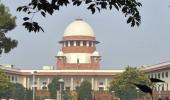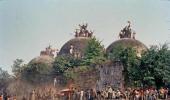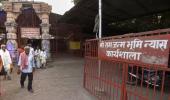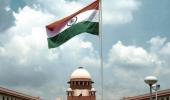Indian politics, held captive in one way or the other by Ayodhya, may now well seek its emancipation from this issue, and the pursuit of welfare, asserts Congress leader Salman Khurshid in this excerpt from his latest book, Sunrise over Ayodhya.

The Judgment: Final Word
There are generally always winners and losers in a judgment, depending on how the two parties perceive their claims and the result of the case. But for the lawyer, all that matters is the legal reasoning and the impact the judgment makes as a precedent for future cases.
From that perspective, one might summarise the case as follows.
The case was decided on settled principles of title in property law.
To begin with the first thing one looks at in such cases are the documents of title, which in this case were neither available with the mosque party nor with the temple party.
In the absence of documents or any revenue record -- except that the land was recorded as Nazul or escheat, but the State laid no claim or in effect gave up its claim -- what remained was to take stock of user (that, in the case of a waqf, was enough proof of title) and in conjunction with that the doctrine of lost grant in favour of the Muslims.

Inexplicably, the Muslim side also pleaded adverse possession, but for that they had to admit the initial title of the Hindu side.
The Hindu side laid claim to the property on the grounds that this had been a site of a twelfth-century temple, as established by the ASI excavation, and that the land itself was a deity and thus in was their possession from times immemorial.
All those pleas having been rejected by the court, all that was left for it was to take recourse to the principle of Section 110 of the Evidence Act, 1872, which relies upon possession to grant relief.
The court was able to hold that the Hindu side had established that Hindus had been worshipping at the site and had its possession for at least 100 years prior to 1857 (presumably on accounts of travellers, etc), and that they had exclusive possession of the outer courtyard since then.
The former seems doubtful, while the latter was admitted by the Muslim side.
On the other hand, the Muslim side could show exclusive possession of the inner courtyard only since 1857.
In the absence of claim to partition the two courtyards, the court found itself compelled to decide the fate of the entire property and, on a balance of probability, held that the Hindus had established possessory title.

Yet there seems no mention in the entire discussion by the court of the fact that Babri Masjid was registered as a waqf property and, by virtue of the gazette notification, that becomes final and binding on the whole world, unless challenged within one year.
It is surprising that Zafaryab Jilani, who argued on behalf of the Personal Law Board, did not rely upon this fact, given the noise he had made about the issue when the Waqf Amendment Act was passed in 2013 under my stewardship of the Ministry of Minority Affairs.
We were cleaning up the Act and clarifying the jurisdiction of the revamped Waqf Tribunals.
Since there was an existing provision for the registration of all waqfs, we provided for tribunals to hear matters pertaining to registered waqfs, with unregistered waqfs being in the purview of the civil courts.
Jilani publicly decried that to be an attempt by the UPA government to derail the Babri Masjid case.
No effort to explain the logic worked on him or the Personal Law Board. In fact, a little research disclosed that the Babri Masjid was indeed registered many decades ago, in 1944, under the UP Waqf Act, 1936, but the Faizabad civil court had rejected the registration in 1966, due to inadequate details of the mutawallis.
Subsequently, it was once again registered and given the same registration number: no. 26.
That registration should have been used to bolster the case of the masjid. However, although in the written submissions it was argued that the 1944 registration being held void would not affect the validity of the waqf, there is no mention that there was a fresh registration--one that has not been questioned or held void.
Perhaps when the case is examined dispassionately, history will judge how diligently and effectively the case of the masjid was presented by those who made a lifetime career of political advocacy.
Who is there to blame now, unlike in the past when they made a point to campaign in my constituency, Farrukhabad, and against Sonia Gandhi in Amethi?

After the Ayodhya verdict, there was no impromptu celebration or protest across the length and breadth of India.
All political parties had repeatedly announced their resolve to abide by the decision of the Supreme Court, and that was what they did, with the exception of individual leaders repeatedly voicing their support for a 'bhavya mandir' without any mention of the masjid.
Meanwhile, despite reiterating their position to accept the court's decision, the Muslim parties went into a huddle to ponder over the possibility of filing a review and generally rejecting the offer of 5 acres of 'charity'.
Gradually, Ayodhya began to look like a contest between Hindu groups (Nirmohi Akhara versus the Temple Trust to be established) on the one hand and Muslim groups on the other (Muslim Personal Law Board and Babri Masjid Committee versus the Sunni Waqf Board).
The differences among the latter surfaced in the ungainly 'sacking' of Rajeev Dhawan, the senior counsel who did an admirable job for the Muslim cause. His tireless advocacy before the constitution bench had several dramatic moments, including when he tore a site plan presented by another counsel on behalf of the temple.
The chief justice had probably meant to be ironic in suggesting that the document could be torn up, but it took the inimitable Dr Dhawan to show such candour and actually do it.

An important point must be made about the monopoly sought by certain groups among Hindus and Muslims to represent the respective cause of the two communities.
What should have been a matter for widespread consultation with opinion-makers and community leaders was kept close to the chest of a few lawyers and their self-professed clients.
During the early stages of the hearing, with the court giving instructions for the tidying up of the voluminous record, some groups that had laboriously collected material, which would have been immensely helpful, attempted to be impleaded or at least be allowed to intervene.
But vigorous opposition by the counsel for the Waqf Board left the court helpless in the matter.
Surprisingly, even the offer to merely file all the material was resisted.
Unelected representatives chose to decide the future of entire communities, obstinately obstructing any fresh inputs or participation.
Sadly, the price will be paid by those who were never told why something was done -- why some members of the community decided they must be the only voice of the community, and speak for all, for better or worse.
Thus far we have not seen signs of people celebrating their victory or defeat, but many are convinced that the building of the temple will not be without considerable political fanfare and careful calibration of schedules to match election dates.
But as they say, a closed fist fascinates only till it is opened and the truth becomes apparent.
Indian politics, held captive in one way or the other by Ayodhya, may now well seek its emancipation from this issue, and the pursuit of welfare.

The unanimity among the five justices, both unusual and perhaps consciously accomplished, served a purpose: Of underscoring our social need for unity. But scholars and professionals remain perplexed about the addenda attached to the judgment.
If it was a draft judgment, it certainly points to a wide difference of opinion about the nature of the task assumed by the court.
While the judgment firmly rejects appeals to faith (except to the limited extent of evidence of conduct) and avowedly sticks to the principles of evidence relevant to the title suit, the addenda squarely reposes trust in faith, as it were, and goes on to find that Hindus' faith in the Ram Janmabhoomi or the Ram Janmasthan must trump other considerations of possession and title.
Is the present judgment, then, a compromise between faith and law that therefore looks a little askew because of the court's reluctance to acknowledge that?
This is not the first time that reluctance to acknowledge the role of faith has forced the court to tread into slippery territory.
In the entire series of cases concerning the banning of cow slaughter,* the court's reluctance to read the cow slaughter-related directive principles as being concerned with the Hindu faith forced it to take positions that were neither Constitutionally consistent nor sustainable over a period on the grounds of technological changes and best practices in animal husbandry.

A Summary of the Findings
The mosque was built on the remains of a religious structure, possibly a Hindu one, from the twelfth century, as per the ASI. But it can't be said that it was a temple or, more importantly, that a temple was demolished to build the mosque. That virtually rejected the case made by the RSS and VHP, and justified their demand for reparation for the destruction of their temple.
There was no case of the Swayambhu deity established, neither on grounds of theology nor on the facts as proved.
The essential element -- of the manifestation of divine character -- was missing. In the absence of a consecrated deity, it could not be said that the janmasthan, too, was a juristic person.
It was conceded by the Muslim side that Hindus worshipped Lord Ram on the chabutra in the outer courtyard of the mosque and that Lord Ram was born in Ayodhya. However, the idea that the concession about one clearly demarcated part of the property should have impact on the status of the other part is surprising.
The Muslim side was unable to show evidence that Muslims had continued to pray in the mosque from 1528 to 1856-57. But throughout, the court had accepted that it was a mosque and was never abandoned, and even when obstructions were created for people to visit the mosque, Friday prayers continued to be performed there till the idols were placed.
Since there was no proof of dedication, and uninterrupted use was not established, it could not be said that there was a waqf.
This was held despite the court finding that from 1934 to 1949 the keys of the mosque remained with the Muslims, but since they had to traverse past the Hindu places of worship, like the chabutra and Sita Rasoi, they were able to perform namaz only on Fridays.

The last word, for the present, on the judgment: Despite the careful steps to find a balance between stated legal principles and acceptability by the masses, but with a concern to keep the secular fabric of our society intact, it will be said that ultimately the case was decided on the basis of the myopic pleadings of the Muslim side not seeking the portion that was admittedly the mosque.

Besides that, there was the backdrop of the rejection of their claim of adverse possession, inexplicably sought against the non-owner.
Finally, of course, the somewhat obscure concept of possessory title of the mosque being held to be doubtful because the other side made periodic attempts to intrude and occupy.
All this gives sadly the impression that the wrongdoer generally benefits. As does the candid admission by the court that Article 142 would be used to do complete justice by holding that the inner courtyard was established to be a mosque yet it would remain a contentious issue, since it would be surrounded and virtually landlocked by the mandir property.
* Mohd. Hanif Quareshi and Others vs State of Bihar, 1959, SCR 629; State of Gujarat vs Mirzapur Moti Kureshi Kassab Jamat and Others, 2005, 8 SCC 534.
Excerpted from Sunrise over Ayodhya by Salman Khurshid with the kind permission of the publishers, Penguin Random House India.
Feature Presentation: Ashish Narsale/Rediff.com










